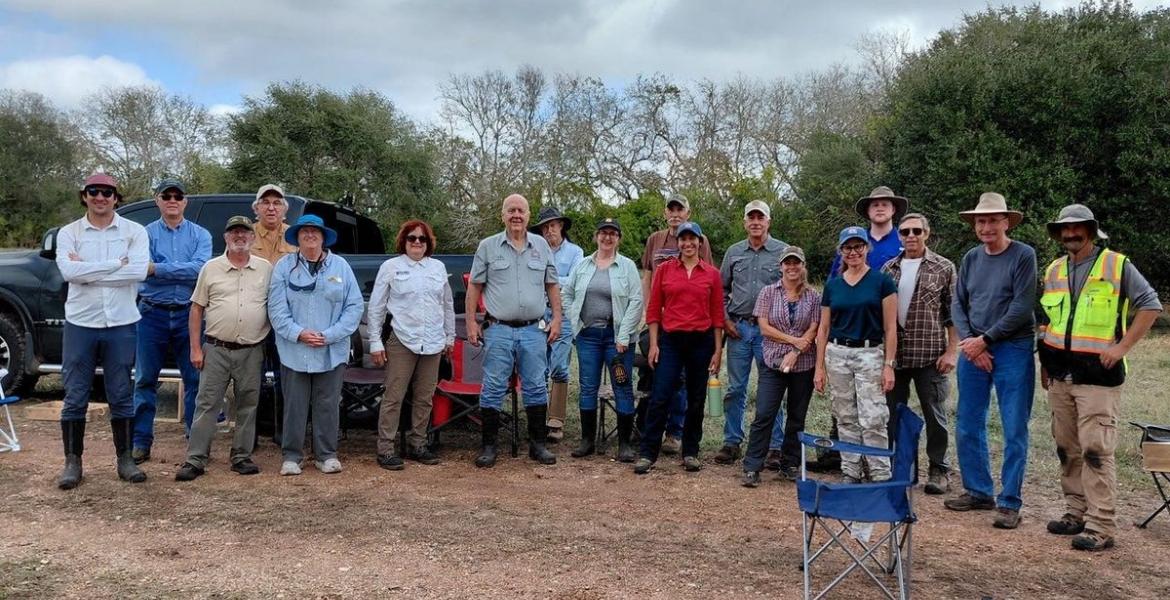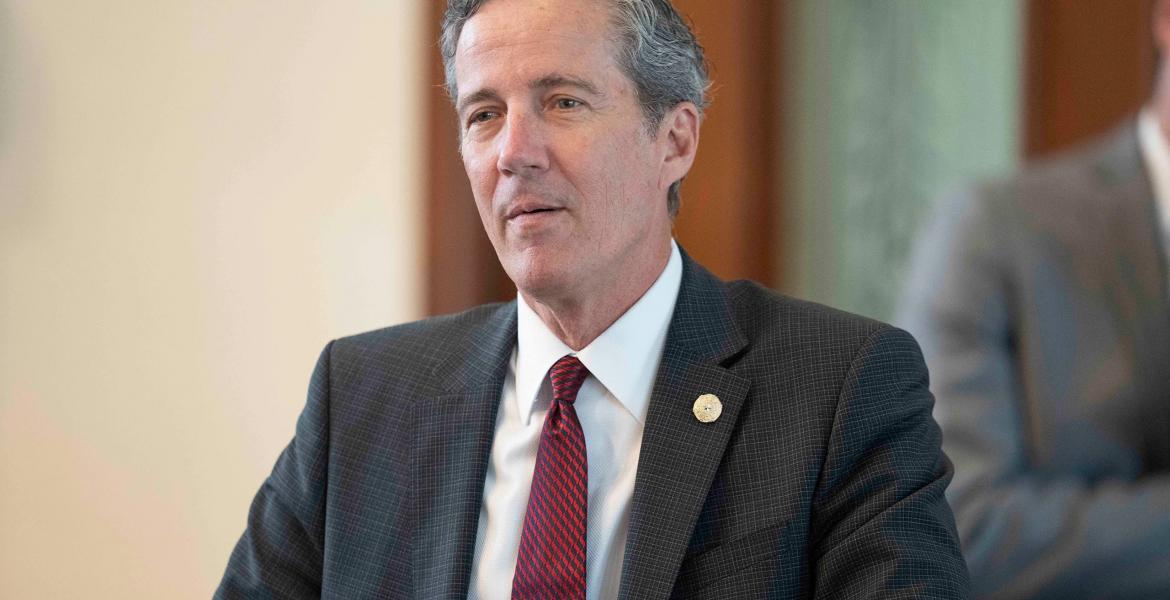A faded black and white portrait depicting a man in a jacket and vest sat displayed in the Fort Chadbourne Visitor’s Center on Saturday, the emblem of the Texas Rangers on one side, a Masonic symbol on the other.
At least 30 people, some employees of the museum and gift shop, others history buffs, former Rangers and visitors, sat facing the center’s “branding wall”, listening intently to the story of a man who walked on this earth over 130 years ago.
“My family came here in the 1873-1874 time period,” said Fort Chadbourne Foundation President Garland Richards. “At one time the ranch encompassed approximately 150,000 acres. In 1885, we ran into a severe drought situation where the grass was short and the water was scarce, very similar to what San Angelo and Abilene has seen in the last seven years.”
That drought is where the story of Texas Ranger Benjamin Goodwin Warren begins, Garland explained, recalling years of history lived by his great-great-great-grandfather Thomas L. Odom that centers on a fight over land and its scarce resources.
“The water dried up and some of the ranchers starting fencing some of their property,” Garland said. “This caused what was considered ‘the fence-cutting wars’.
As the drought began to take its toll on the area, private ranchers began stretching miles of barbed wire around their property, marking the lines and keeping out free-roaming cattlemen who had grazed their herds on the property of others for decades before.
With water in short supply and grass even shorter, the free-roaming cattlemen were cut off from resources they need to nourish their herds and began cutting wires and burning down portions of privately-owned land.
“My great-great-great-grandfather (Odom) was in the state legislature and enacted some of the laws to make it a felony crime to cut another man’s fence,” Garland said.
A short film Richards had made telling the story of Ranger Warren explained that Odom was greatly affected by fence-cutters, who had taken out miles of his own wire in a single night.
Odom approached the Texas Rangers with an idea for an undercover operation to catch the fence cutters, and only Benjamin Warren volunteered for the task.
Warren’s job was “to infiltrate the Fish Creek Fence Cutters Gang, named after a small creek about six miles from where we stand today,” Fort Chadbourne Secretary Lana Richards explained to those who had gathered. “Warren would approach the gang, befriend them in their nightly raids, and in a short time had the goods it would take to arrest and indict the gang.”
Lana explained that eight men were ultimately arrested for fence cutting, but all made bond. On the night before their trials were set to begin, Thomas Odom and Ranger Ben Warren were seated around the stove in the Sweetwater Hotel office when a shot rang out and penetrated a window, hitting Warren in the face and killing him instantly.
“A week after the murder, Thomas Odom and Warren’s brother placed Warren in a wagon and brought him back to Fort Chadbourne and buried him,” Lana said. “He was survived by his wife and 10 children, one whom was born eight months after his murder.”
For the past century and 30 years, Texas Ranger Benjamin Warren’s body has lain in the Fort Chadbourne Cemetery, just 20 yards from the Odom family plot. For years his grave has been marked by a large gravestone, but on Saturday, Garland Richards, the great-great-great-grandson of the man that buried Warren in 1885, hosted a dedication ceremony on the fort grounds finally marking Warren’s grave with an official Texas Rangers cross.
Members of the Former Texas Rangers Foundation and the Masonic Rangers were in attendance, lending insight on the state’s law enforcement agency and honoring Warren’s memory.
Masonic Rangers Chairman Dick Brown explained the close relationship the Texas Rangers have had with the Masons for nearly two centuries, noting Warren was a member of both organizations.
“It’s said that the badge of a Ranger recommends a man to be made a mason, and the badge of a mason recommends to be made a Ranger, because we share a lot of the same values,” Brown said. “Our brother Ben Warran was made a mason, but we don’t know when he was…we couldn’t find any records, because back then, the records were poorly kept…we know he lived his life in a manner that when he died his Masonic brothers placed the Masonic symbols—a square and compass—upon his gravestone.”
Joe Davis, President of the Former Texas Rangers Foundation, also addressed the crowd that had gathered, explaining the history of the association that started 12 years after Ranger Warren was murdered.
“Former Texas Rangers had served together, most of them in a frontier battalion like Ranger Warren served,” Davis said. “They got together [because] they missed each other. When they were camping together, they became like family. They lived together.”
The former Rangers then began meeting up at Ranger camps throughout the state, including ones in Menard and San Saba. Now, Davis said, the foundation focuses on preserving the history of the Texas Rangers through education, putting up signage at landmarks and running a museum.
“Our association has now done over 640 of these crosses around the state,” Davis said. “So if you see that cross, it began in 1999 in a cemetery in Kerrville that 32 Rangers are buried in. It’s kind of expanded. Every weekend, we’re doing a cross ceremony.”
A large photo printout of the gravesite and the cross was made to suffice for Saturday’s ceremony, when storms and accumulating water made the roads through the cemetery unsafe for passage.
As Garland unveiled the picture of the gravesite, a man in period dress played a bugle in the room, each taking off their hats and facing the flag as he played.
Eyes glinting with almost tearful emotion, Garland explained after the ceremony that one of the guests in attendance believes he may be in possession of the gun that killed Ranger Warren on Feb. 10, 1885.
The man, Garland explained, is a descendent of the fence-cutting gang believed to be responsible for Warren’s death the night before the trials were to begin.
“We assumed that this was a rifle [that killed Warren],” Garland said. “There was a 44-40 rifle and there was a 44-40 pistol. One was made by Colt, one was made by Winchester. They both shot the same ammunition. We had reports that it was a 44-40. We assumed that it was a Winchester, it could have possibly been a Colt. It’s something with a little bit of investigation we may find out.”
Garland said he and the staff of Fort Chadbourne will be researching the murder extensively with the hope of determining whether or not the gun was used. If it was, the man has agreed to put it in the collection at the fort’s museum.
“This literally ran cold chills up my back when I reached down and was able to pick up this gun that this man brought to me today,” Garland said. “It’s almost like the completion of the story. We’ll see how it turns out.”
Subscribe to the LIVE! Daily
Required






Post a comment to this article here: